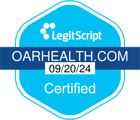What Is ‘the Sinclair Method’ and Does It Work?

In This Article
Medically reviewed by Joshua D Lee, MD, MSc, written by Jennifer Chesak
In a nutshell, the Sinclair Method (TSM) is a medication-assisted, evidence-based form of treatment for alcohol use disorder (AUD). Via the use of the prescription drug naltrexone, TSM addresses the reward pathways of the brain involved in substance dependence (1).
Many forms of addiction treatment rely on the strategy of sobriety or abstinence. But strict abstinence doesn’t work for everyone. Alcoholics Anonymous (AA) is an example of a treatment program generally based on the goal of complete abstinence from alcohol and drugs, but there are many alternatives to AA which support goals of both abstinence and moderation.
Researchers say evidence does not support abstinence as being the only treatment approach (2). In other words, you have other options, including TSM.
TSM, developed by Dr. John Sinclair, actually relies on continued consumption of alcohol — at least at first — to work. But over time, TSM may help you drink less or stop altogether (1).
How does the Sinclair Method work?
TSM uses the prescription medication naltrexone to change the way your brain associates alcohol with reward. Naltrexone prevents the flood of feel-good endorphins that alcohol provides (1).
To follow TSM, you take naltrexone every time before drinking alcohol. With the endorphin release caused by alcohol effectively blocked, you won’t experience a buzz.
Eventually, the drink-equals-reward pattern gets interrupted because alcohol no longer presents that feel-good sensation. Without the reward, cravings typically diminish, leading to less drinking or even complete abstinence.
However, anyone following TSM should be aware that alcohol will still cause impairment, which, according to the National Institute on Alcohol Abuse and Alcoholism, includes “nearly every aspect of information processing by the brain” (3).
Naltrexone
Naltrexone is a medication that was approved by the Food and Drug Administration (FDA) in 1994 to treat AUD. It is an opioid antagonist and works by binding to opioid receptors, where it blocks the absorption of endorphins (4).
Endorphins and alcohol
Endorphins are the brain’s naturally occurring opioids. They create a general feeling of well-being, stress relief, and pain relief (4).
Research indicates people may have differences in the amount of endorphins just one drink of alcohol elicits. Therefore, some people may experience a bigger reward or pleasure hit from alcohol, making them more susceptible to heavier drinking (5).
Does the Sinclair Method work?
Yes, TSM can be effective.
The TSM website claims that the method has a 78% success rate. But it does not define success as abstinence. Instead, it lets you define what success means to you.
The TSM website describes success as the “degree of freedom you have from alcohol.” As an example, one metric may be your lack of obsessing or preoccupation about alcohol or drinking (6).
No large randomized controlled trials (RCT) of TSM have been published. While large RCTs are considered the “gold standard” of health outcomes research, several smaller studies of targeted naltrexone use suggest promising results.
A study of 150 problem drinkers found that participants who took naltrexone on a targeted schedule reduced their drinking more than participants taking a placebo daily. Participants in the “targeted” group were instructed to take naltrexone 1-2 hours before entering a situation deemed high risk for heavy drinking (7).
Does naltrexone work?
Yes, several decades of research show that naltrexone is effective.
The COMBINE trial was a 16-week clinical trial of naltrexone used in 952 people with alcohol dependence (8). The COMBINE trial’s main results indicated naltrexone plus medical management counseling was as effective or more effective than other more intensive medication and counseling regimes. A secondary analysis of the study, published in the journal Frontiers in Psychology, suggested that naltrexone reduces heavy drinking in regular drinkers (9).
In addition, the study outlines previous initial research in laboratory settings and in clinical trial findings.
Naltrexone in initial research:
- dulls alcohol’s positive reinforcing effects
- lessens alcohol cravings
- reduces alcohol consumption
- slows progression of drinking
- increases negative effects of alcohol, like fatigue
Naltrexone in clinical trials:
- reduces number of heavy drinking days
- reduces number of drinking days overall
- reduces the number of drinks per drinking episode
- increases time to first relapse
- is associated with lower relapse rates
Components of the Sinclair Method
TSM is all about operant conditioning. A person with AUD is conditioned to associate drinking with receiving a feel-good incentive. By continuing to drink but not receiving a buzz — thanks to naltrexone’s endorphin-blocking effects — the conditioning changes. Alcohol is no longer rewarding. So, a person may drink less.
Drinking less helps reduce the negative consequences of alcohol as well. Eventually, a person may become abstinent through TSM (10, 11).
Positive reinforcement
AUD is rooted in both positive and negative reinforcement. Whether it’s a buzzed or relaxed sensation, that intoxicated feeling from alcohol is a little different for everyone.
But alcohol acts upon the reward pathways in the brain, causing the release of endorphins. And that feel-good “reward” is what can lead to wanting more alcohol.
The activity (the drinking of the alcohol) coupled with the reward (that good feeling) leads to what’s called positive reinforcement (11).
Negative reinforcement
Negative reinforcement can play a role in AUD as well. Heavy drinking can lead to anxiety, depression, withdrawal, and other unwelcome symptoms. Those negative experiences can create the urge for more alcohol to escape the perceived punishment and regain the reward (11).
Extinction
“Extinction” (or pharmacological extinction) is a term often used with TSM. Extinction simply refers to the process of ending the association of alcohol as reward (12).
Extinction of the association of alcohol as a reward takes time, and the length is different for everyone. But extinction is why TSM doesn’t use abstinence as a treatment method.
If someone abstains from alcohol immediately, they won’t “unlearn” the reward association. Alcohol may continue to represent a feel-good payoff, even long into sobriety. And cravings may lead to relapse.
A key component of TSM is taking naltrexone every time before drinking so your brain no longer connects alcohol with a bonus.
Under TSM, people take naltrexone an hour before planning to drink. However, some people choose to take naltrexone every day, just in case.
What else do I need to know?
TSM may not be for everyone. Or it may be best used with other treatment methods in some people.
TSM also does not address underlying trauma or mental health conditions that could lead someone to self-medicate with alcohol.
You may have triggers — such as stress, anxiety, or interpersonal relationship issues — that spark the urge to drink. A mental health professional can help you develop coping strategies that don’t involve alcohol. You can engage with a mental health professional while using TSM.
If you must remain sober for health reasons or if you’ve been court-ordered not to drink, TSM won’t be the right method for you.
Remember, TSM relies on continued drinking, at least at first, to break the cycle of drinking-equals-reward.
Naltrexone blocks opioid receptors. If you must take opioid pain medications for a surgery or other reason, you’ll need to stop taking naltrexone.
Takeaway
TSM is a medication-assisted form of treatment to help you drink less or even eventually quit drinking. It involves taking naltrexone every time before drinking to block the endorphin release alcohol provides.
Over time, this process conditions your brain to stop thinking of alcohol as a reward. You might then drink less or even stop drinking completely.
About the writer: Jennifer Chesak is a freelance medical journalist, editor, and fact-checker with more than two decades of experience and bylines in several national publications. Follow her @jenchesak.
About The Author
Josh Lee is a clinician and researcher with a focus on medication-assisted treatment of alcohol and opioid use disorders. He has conducted multiple clinical trials examining the use of naltrexone in primary care and other community settings. As a practicing physician, Josh helps manage the NYC Health + Hospitals/Bellevue addiction medicine clinic in adult primary care.
Related Articles
- How It Works
- Alcohol & Health
- Alcohol Misuse & Alcohol Use Disorder
- Strategies to Drink Less or Quit
- Treatment Options
- Medication-Assisted Treatment
- Recovery Stories
- Member Stories
- Moderation Stories
- Sobriety Stories
- ¹ Oar Health membership plans include access to the Oar Health platform, virtual consultations with a healthcare professional, and medication if prescribed by a healthcare provider. 3 month membership plan costs $297, equating to $99/mo.
- ² Self-reported by members after 6 months of Oar Health membership.
- ³ Verywell Health survey of Oar Health members, published March, 2023.
- ⁴ Prescription medication is available only if prescribed by a licensed clinician.
- ⁵ Compounded medications are prepared based on a prescription from a healthcare provider. They are not reviewed by the FDA for safety or efficacy.






